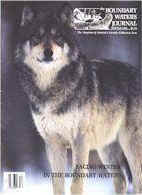

Sidebar to "The Quin-zhee Shelter"
FROM THE BOUNDARY WATERS JOURNAL / WINTER 1987
BUILDING A QUIN-ZHEE
IN THE BWCAW
By C. Mark Sakry
1. Choosing a site: Flat ice is the common choice of winter campers when chosing a site for a quin-zhee [kwahn-chee] because it is level, and there is plenty of snow on northern lakes for heaping into big piles. I prefer land when I can find a hill near camp where snow can be easily shoved down from above. But you must level a "false floor" out of snow on the side of a hill. (I build-up the sleeping level anyway—even on flat ice—for reasons I will explain.)
2. Piling snow: Romantics use snowshoes—which work fine—but shovels work better. It is worth taking one along. But not one of those dinky short-handled ones if you can help it. Bring one you can stand up with. It’s more efficient, easier on the back. Heap snow into a pile about 6-8 feet high and 12-16 feet in diameter for sleeping three or four people (and maybe a dog). Then go for hot cocoa. Give it about an hour to settle. Dry powder snow bonds (sinters) when it is disturbed, providing a nice solid structure on which your whole crew can stand in a day or two … without collapse!
3. lnterior dimensions: For a sturdy dome, walls should taper from a thickness of about eight inches on top to 16 inches at the base. It helps to stick twigs into the pile here and there—to the depth of your desired wall thickness—to signal you on the inside when you scrape it out. (In any event, you will want to stop scraping where you see daylight illuminating the snow on the inside!)
4. Digging it out: Put on your rain suit. Some like their door about the size of a No. 3 Duluth pack—for, respectively, stuffing shut. I don't. I make mine lnuit-size, just big enough to crawl through. Either way, removing snow is no problem. A shovel can be easily manipulated through the pack-size hole, to start—followed by more careful manual scraping with an aluminum bucket or plate, once inside. I've even seen a pulk (small sled) used for shuttling snow through the entryway to the outside. My smaller doorway requires a slightly bolder method: I gouge a big—BIG—opening to start, big enough to get my shoulders in with a shovel. Once I have finished the interior work (and moved all bulky gear inside)—I seal it back up with blocks of sintered snow from the piles outside, carefully shoveling heaps of snow on top of that until I have an entryway "jutting" from the side of the shelter. It settles fast enough that you don't have to wait so I start-in right away with my Inuit-size tunnel to the interior of the dome at ground level. I make my entryway on the lee side of the wind, when I can.
5. Inside refinements: The secet to super-comfort inside a quin-zhee can be found in one simple modification … an elevated "false floor" at a level above the top lip of the door on the outside. This traps the higher relative warmth inside (because heat rises) and virtually eliminates draft without sacrificing ventilation. I do not poke vent holes in the ceiling; nor do I plug-up the door. I keep my entryway open. Since draft has been eliminated, heat cannot be lost through convection. Yet there remains a safe and constant exchange of air with the outside for suitable ventlation. I have tested many variations of the quin-zhee shelter, and this is the warmest. (Thermal retention is significant even if the floor is a few inches below the top lip of the door!) The only trade-off is that you sacrifice some surface area at this higher level. A "jutting" entryway lets you conserve some floor space—by letting you enter the dome outside the circumference of your sleeping area—but if you really need to stretch out, dig it down to the ice. Just don't drill any fishing holes within several hundred feet of your shelter lest you get drenched! Whatever method you use, don't forget to add one or two alcoves for candles—for a lovely finishing touch.
THE BOUNDARY WATERS JOURNAL / WINTER
1987MAIN ARTICLE:
The Quin-Zhee Shelter
RELATED ARTICLES:
An Early Winter Journey
Danger: Thin Ice!
Snowcamp: Romancing Winter in the Lake Superior Wilderness
Get Ready to Camp in Winter
Cold-Weather Deer Quiz